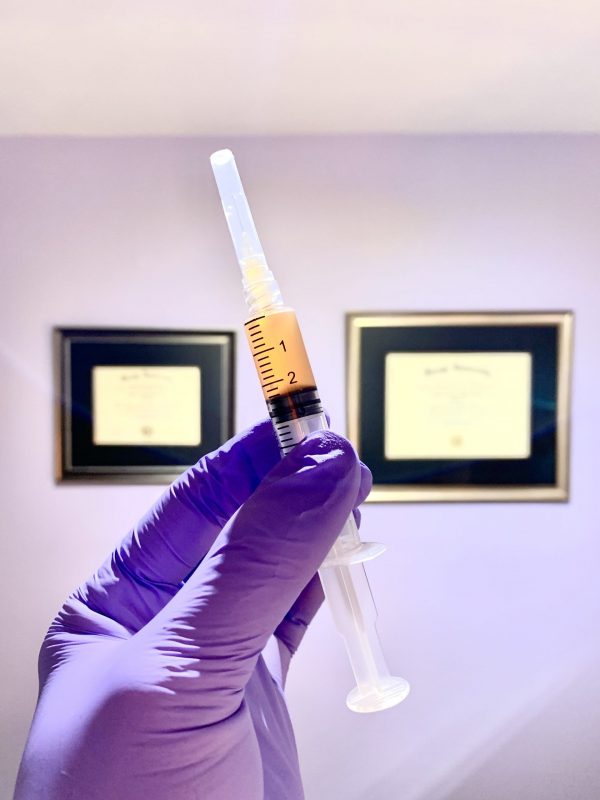
Have you received a diagnosis of osteoarthritis of the knee?
This is the “wear and tear” breakdown of cartilage of the knee joint, leading to inflammation and resulting symptoms of:
- pain
- swelling
- restricted mobility
Have you heard of Platelet-Rich Plasma (PRP)? Read on to learn more about this next generation innovative treatment!
Treatment for Knee Osteoarthritis
According to the U.S. Centers for Disease Control and Prevention, osteoarthritis in general affects:
- 13.9 percent of adults aged 25 and older
- 33.6 percent of those older than 65.
At the late stage of severe degeneration, partial or total knee replacement may be considered, as a way of replacing diseased bone with an implant. At earlier stages, less invasive arthroscopic surgery may be performed to repair torn cartilage.
Non-surgical approaches could range from application of ice and heat or gentle exercise to increase range of motion to acupuncture or over-the-counter medication like acetaminophen.
Injection Methods Including Platelet-Rich Plasma (PRP)
Another minimally invasive option involves types of injections – cortisone, hyaluronic acid, stem cells or platelet-rich plasma (PRP).
Many orthopedic specialists consider PRP to be more effective and long-lasting than other types of injection in stimulating repair of cartilage, torn meniscus and ligaments, thus reducing swelling and pain and delaying the need for joint replacement surgery.
The procedure of PRP involves collecting a small amount of blood, spinning it on a centrifuge to concentrate and separate the platelets containing growth factors from the red cells, and injecting the platelets into the joint.
This is a safe and comfortable procedure to enhance a natural healing process of tissue regeneration.
Evidence For Effectiveness of PRP
What is the evidence for effectiveness of PRP for treatment of knee osteoarthritis?
A review of 14 randomized controlled trials with a total of 1,423 participants indicated that PRP significantly reduced pain scores and improved physical function, with minimal side-effects (1). A study in the medical journal Orthopade concluded that “Intra-articular PRP injections into the knee for symptomatic early stages of knee osteoarthritis are a valid treatment option” and “the long-term efficacy of intra-articular PRP is superior to intra-articular hyaluronic acid and intra-articular cortisone.”(2)
Another study confirmed that “platelet-rich plasma therapy is a simple, low-cost and minimally invasive intervention which is feasible to deliver in primary care to treat degenerative lesions of articular cartilage of the knee.”(3) The average participant in this study was obese and obesity is known to be a contributing factor to osteoarthritis in the lower extremities.
Research from the Mayo Clinic agreed that PRP is a safe and effective option for knee osteoarthritis, while treatment benefits seemed to wane after 6-9 months (4).
Another study found that symptomatic relief lasted for up to 12 months, with some risk of local adverse reactions after multiple PRP injections (5), although other studies have found no increased risk of adverse reactions.
Arresting Degeneration (Knee Osteoarthritis) in Athletic Injuries
Athletes are known to have an earlier onset and greater prevalence of knee osteoarthritis. Self-administered remedies such as ice, knee braces and anti-inflammatory medications fail to arrest further degeneration of the joint.
However, a study by researchers at the Hospital for Special Surgery (New York) has shown that PRP not only improved pain and function in arthritic knees, but in up to 73 percent of patients appeared to delay the progression of the disease. While it is usual for patients with osteoarthritis of the knee to lose about 5 percent of knee cartilage per year, this study demonstrated through MRI assessment no progression of arthritis in a majority of the participants. While success in PRP studies is often measured through pain or physical function scales or questionnaires, another MRI study of PRP, conducted double-blind and controlled on 23 patients, produced objective evidence of significant improvement in radiologic measurements of cartilage volume and integrity (6).
Of course, acceptance of PRP is not universal in the medical community. Keeping with scientific conventions, even studies that apparently demonstrate success in improving pain and physical function and arresting degeneration still counsel the need for further research to achieve greater corroboration and standardization.
For more information on whether PRP is suitable for your condition, call 425-775-6001 for your free consultation.
References
- Shen L et al. the temporal effect of platelet-rich plasma on pain and physical function in the treatment of knee osteoarthritis: systematic review and meta-analysis of randomized controlled trials. J Orthop Surg Res. 2017;12:16.
- Huang Y et al. Intra-Articular Injections of Platelet-rich Plasma, Hyaluronic Acid or Corticosteroids For Knee Osteoarthrits: A Prospective Randomized Controlled Study. Orthopade 2019 Mar; 48(3): 239-247.
- Glynn LG et al. Platelet-rich plasma (PRP) therapy for knee arthritis: a feasibility study in primary care. Pilot Feasibility Stud 2018; 4:93.
- Pourche AM et al. Intraarticular Platelet-Rich Plasma Injection in the Treatment of Knee Osteoarthritis: Review and Recommendations. Am J Phys Med Rehabil. 2014 Nov; 93(11 Suppl 3): S108-21.
- Campbell KA et al. Does Intra-articular Platelet-Rich Plasma Injection Provide Clinically Superior Outcomes Compared With Other Therapies in the Treatment of Knee Osteoarthritis? A Systematic Review of Overlapping Meta-analyses. Arthroscopy. 2015 Nov; 31(11): 2213-21.
- Halpern B et al. Clinical and MRI Outcomes After Platelet-Rich Plasma Treatment For Knee Osteoarthritis. Clin J Sport Med. 2013 May; 23(3): 238-9.
- Raeissadat SA et al. MRI Changes After Platelet Rich Plasma Injection in Knee Osteoarthritis (Randomized Clinical Trial). J Pain Res. 2020; 13: 65-73
